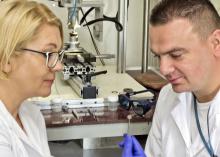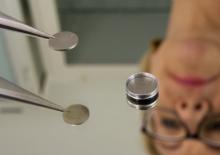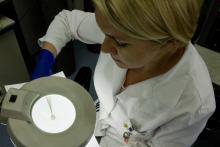NCBJ scientists have presented some promising results of research on targets suitable for production of technetium-99m, one of the nuclear medicine more important isotopes, in accelerators. Their paper appeared in the June edition of the Applied Radiation and Isotopes journal.
A proprietary method to produce targets suitable for production of technetium-99m in accelerators was developed in NCBJ Radioisotope Centre (POLATOM). Technetium-99m is applied in medical diagnostic procedures performed worldwide millions of times each year. POLATOM is producing and delivering to several countries generators capable to produce 99mTc directly in hospitals. The generators contain molybdenum-99 which decays to technetium-99m. 99Mo is produced from uranium targets irradiated in several nuclear research reactors, including the NCBJ-operated Maria reactor. However, alternative methods to produce technetium-99m in accelerators have been intensively searched since the last global crisis in supplies of molybdenum-99.
Technetium-99m may be accelerator-produced using reactions of protons with 100Mo, a stable molybdenum isotope. – “Molybdenum targets to be irradiated in accelerators must first of all be highly enriched and chemically pure, otherwise some undesired isotopes might be produced in result of proton irradiation.” – explains Dr. Izabela Cieszykowska from POLATOM, leader of the project. – “The targets must be mechanically strong enough to survive bombarding by intense proton beams, but also porous enough to enable quick dissolving after irradiation (in order to enable efficient extraction of the produced technetium-99m, a short-lived isotope with half-life of only about 6 hours). Finally, their thermal and electrical conductivity must be high enough.”
NCBJ scientists have proposed to press molybdenum-100 enriched molybdenum powder into 1 cm dia and less than 1 mm thick pellets, then to sinter the pellets in a hydrogen atmosphere. Mechanical strength of such targets is strongly dependent on the pressing pressure and the sintering time. The pellets were tested in NCBJ Material Research Lab. The most promising samples were irradiated with protons delivered by the GE-PETtrace cyclotron operated in Warsaw University Heavy Ion Lab (ŚLCJ). – “We have developed and optimized a method to produce molybdenum targets which are sufficiently strong during irradiation with proton beams and at the same time capable to be dissolved after irradiation quickly enough to be efficiently processed” – added Dr. Cieszykowska. – “The proposed method may be successfully implemented at every site employing a typical accelerator to produce isotopes for PET diagnostics.”
The presented research was an element of preparations to start the CERAD (Centre for Design and Synthesis of Molecularly-Targeted Radiopharmaceuticals) project, within framework of which a new cyclotron in Świerk in planned. – "We have demonstrated that we are able to accelerator-produce technetium-99m, but first of all we are considering application of accelerators to produce other radioisotopes useful in medical diagnostics/therapy that were not available so far in Poland, at least not to such an extent” – explains Associate Professor Renata Mikołajczak, CERAD project leader, and member of the team that conducted research on new molybdenum targets. – “We have high hopes concerning e.g. some copper or zirconium isotopes. Astatine-211, an alpha particle emitter, is another example. Short-range alpha particles are locally highly efficient biologically. The formidable challenge is to locate atoms of the isotope precisely within malignant tissue only (or at least very preferentially).”
Research on targets suitable for production of technetium-99m in accelerators was supported by International Atomic Energy Agency and by National Centre for Research and Development (the "Alternative Methods to Produce Technetium-99m” project within the Applied Research Programme, path A). NCBJ scientists cooperated with some colleagues from Warsaw University Heavy Ion Lab and Institute for Nuclear Chemistry and Technology in Warsaw (partners of the CERAD consortium). Other consortium members include Warsaw Medical University, Jagiellonian University Collegium Medicum, Białystok Medical University. The project is accomplished within framework of 4th Priority Axis (“Increasing the research potential”, Action 4.2 "Development of modern research infrastructure in the science sector”) of the Smart Growth Operational Programme 2014-2020 co-funded by European Regional Development Fund.
POLATOM Radioisotope Centre is one of the leading producers/exporters of radiopharmaceuticals in the world. The production is based on radioactive isotopes produced in nuclear reactions induced by neutrons from the Maria research reactor. The new cyclotron planned within the CERAD project will be another facility capable to produce radiopharmaceuticals by means of some nuclear reactions induced by accelerated protons, deuterons or alpha particles.
The "Manufacturing and characterization of molybdenum pellets used as targets for Tc-99m production in cyclotron” paper published in the June edition of the Applied Radiation and Isotopes journal was co-authored by Izabela Cieszykowska, Tomasz Janiak, Tadeusz Barcikowski, Mieczysław Mielcarski and Renata Mikołajczak from NCBJ POLATOM, Jarosław Choiński from ŚLCJ, Marek Barlak from NCBJ Plasma/Ion Beam Technology Division and Łukasz Kurpaska from NCBJ Material Research Lab.








